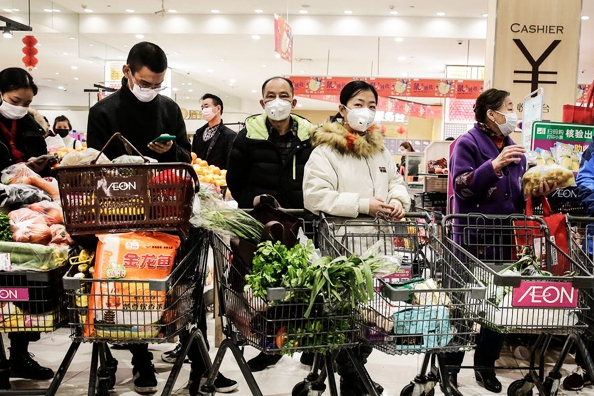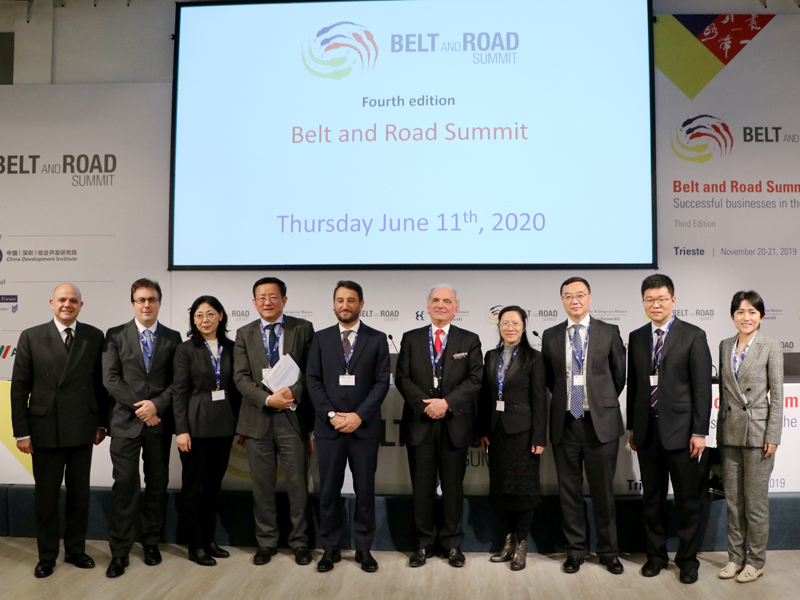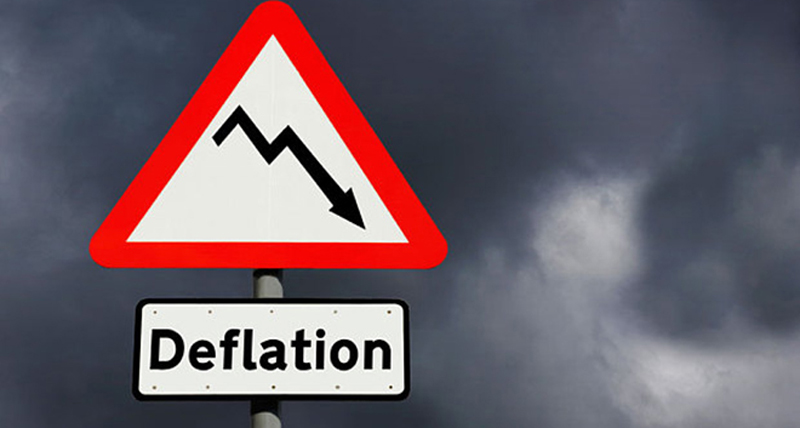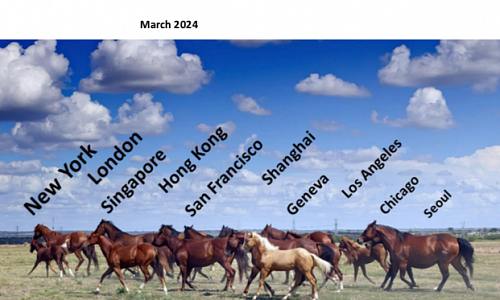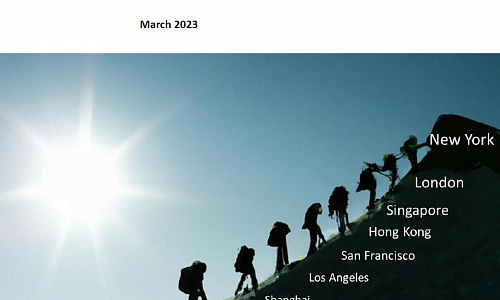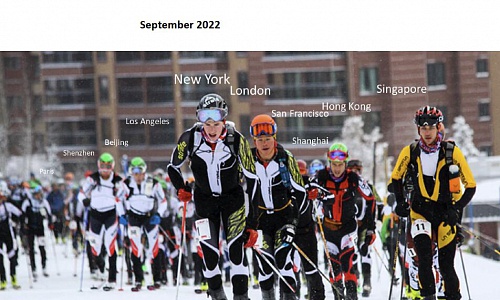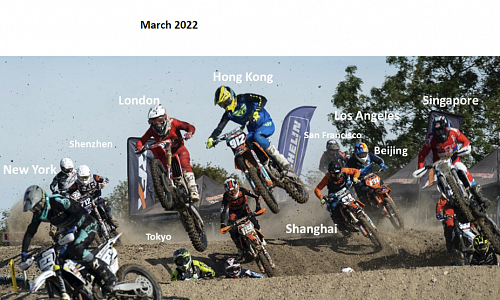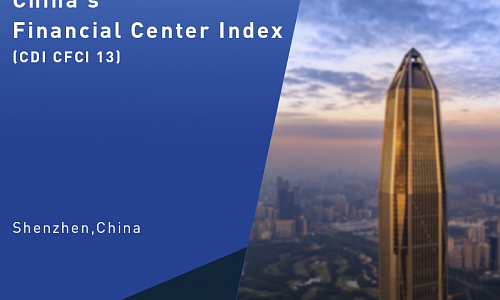Economy will be relatively stable amid global turmoil
The coronavirus outbreak in China has had major short-term negative effects on production activities. However, as of March 18th, within China it is largely contained, with zero new cases. The total number of global infection cases outside China has now surpassed the total number of cases in China, and the number is expanding rapidly. Industrial output in China fell -13.5% y/y in January-February, and investment fell -24.5% y/y. But we believe these two major indicators -- especially investment -- will recover soon.
We believe the Chinese economy and finance may be relatively stable, and recover quickly, amid global turmoil. Many economic activities have already recovered to a large extent, thanks to the “Internet plus” program initiated by the state council two years ago, which allows employees to work at home. The Chinese Central Bank has a long way to cut before reaching a zero interest rate, leaving room for further monetary easing, while other major economies’ central banks, including the Fed, now have interest rates near or at zero. The partially state-owned feature of the Chinese economy enables the government to effectively adopt targeted economic policies, such as extending financial favoritism to SMEs.
Negatively impacted by the curfew, with malls and restaurants closed, retail sales of social consumption goods fell -20.5% y/y. In January-February, exports fell -15.9% y/y, down 20 pps from Q4 2019. Imports fell -2.4% y/y, down 7.6 pps from Q4. Even though we believe these major indicators will recover quickly, the worsening coronavirus situation in other countries will hurt trade. We don’t expect recovery to rebound to its pre-coronavirus level soon.
CPI rose significantly in January-February, by 5.3% y/y, and up 0.8 pps from December, due to transportation segmentation organized for the virus curfew. The collapse of major world commodities such as oil also negatively impacted Chinese producer prices. In February, the ex-factory price index of industrial goods fell -0.4% y/y, and PPI fell -0.5% y/y. Both indicators are continuing their declining trends.
The coronavirus, however, has not had the major impact on Chinese financial markets as it has on other production factors. Major financial indicators are mostly stable. At the end of February, M2 was up 8.8% y/y, the same as at the end of 2019, and M1 was up 4.8% y/y, or 0.4 pps.
Key policy for dealing with COVID-19 is to stimulate immunity of market players

Author: Liu Guohong, Director of Department of Finance Industry
Editor’s Note: COVID-19, ran rampant during China’s Spring Festival. Currently, as the epidemic has been gradually brought under control and remains stable, we need to be alerted to inappropriate response by government departments at different levels, such as frequently rolling out economic policies or extending them to an undue degree, as they may lead to elevated local debt levels, inflation and even economic stagflation. Policies aimed to deal with the epidemic should stabilize market expectations and maintain market ecology, and not swing from side to side. It is important to reinvigorate the market and protect its fundamental mechanisms from harm, instead of taking over everything.
From the demand side, the epidemic coincides with the Spring Festival holiday. Consumption including catering, accommodation, tourism and entertainment has almost dried up. By far, we still cannot estimate how long consumption will remain stagnant, as this depends on the duration of the epidemic. The current complexities in international economy and trade make it difficult to rely on external market for rapid compensation of demand.
From the supply side, the lockdown of cities and roads and the suspension of work in response to the epidemic have resulted in a large number of stranded workers, short supply of production materials and shrinking sales of enterprises, threatening the survival of many small, medium and micro enterprises, while further impelling the shift of the global supply chain out of China since the onset of Sino-U.S. trade frictions in 2018. As they help businesses survive and address human resource issues, government departments shall also closely watch for the potential de-linking of domestic and global sectors, including economy and trade, science and technology and other fields of international exchanges, as well as the resulting cyclical collapse of profit-making capacity.
Given the huge and complicated impact of COVID-19 on the economy, the society expects strong stimulus from the government. However, China’s current debt rate is already elevated, withinflation rate approaching a ten-year high, squeezing the space for fiscal and monetary policies. No government in the world has ever managed to rely on strong stimulus policies to achieve sustainable economic development.
In face of the huge impact of the epidemic, what is most needed is common sense and a rational response with targeted, forward-looking and substantive policies:
- Adhere to stable money supply and respond to inflation expectations in advance; guard against increasingly visible potential inflation expectations that may be caused by the epidemic, ensure proper quantity of money supply with good rhythm, maintain reasonable and sufficient liquidity, and keep market interest rates at proper levels, in a bid to create a stable and predictable monetary and financial environment for both epidemic control and production resumption.
- Lower the statutory deposit reserve ratio in an orderly fashion, release more low-cost funds, reduce the capital cost of financial institutions and improve their balance sheets. Financial institutions will need to deliver reduced capital cost to the real economy and provide feedback on market capitalto regulatory authorities.
- Deepen supply-side financial reform, further open up the financial sector, accelerate market-oriented development of financial institutions, and make financial institutions more sensitive to interest rate, monetary policy signals, market opportunities and economic conditions.
- Priority should be given to ensuring special emergency assistance to directly deal with the impact of the epidemic; ensure that enterprises and industries could safely survive the period of stagnation during the epidemic.
- Increase the scale of special bonds issued by local governments and promote the marketization and transparency of local bonds; moderately expand the scale of special bonds of local governments, strengthen the information disclosure of local bonds, and lower the threshold for local bond investment with improved protection mechanism for investors; encourage and guide local governments to issue bonds in a reasonable way based on market feedback, and improve the quality of investment for post-epidemic economic revival.
- Give full play to the role of professional financial institutions, and capitalize on existing special funds to identify creative investment opportunities engendered by the epidemic, and provide support in a safe and efficient manner.
- Local governments should reasonably introduce economic policies according to the epidemic situation and their own fiscal and taxation realities;they should not blindly subsidize or issue debts in order to overtake competitors, nor should they interfere with market price signals in any irresponsible way or force non-governmental investment out of market.
At present, what is urgently required in dealing with the COVID-19 epidemic is to adopt reasonable and stable policies, mobilize individual wisdom, stimulate market power, and build a more reliable global innovation chain, industrial chain and value chain.
What challenges and changes does COVID-19 mean for china’s urbanization
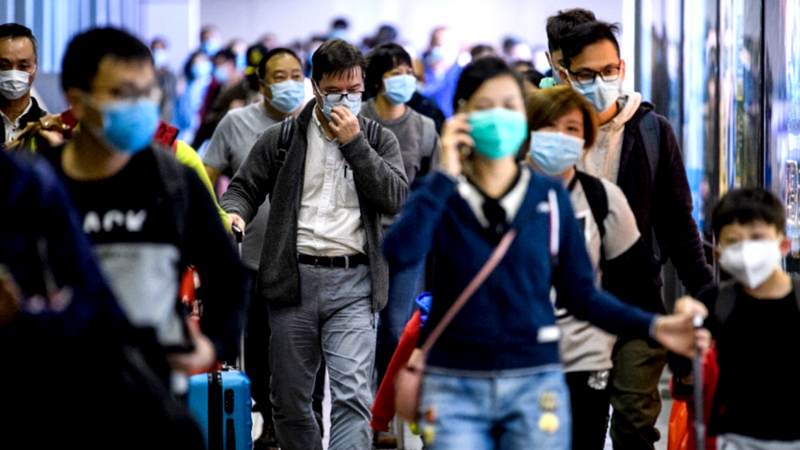
Author: Cao Zhongxiong, Executive Director of New Economy Research Department of CDI
Editor’s Note:The “black swan” incident of the COVID-19 outbreak has led to the temporary shutdown of the global supply chain, making China the “gray rhino” in the world economy. To be sure, COVID-19 will not impede the process of China’s economic transformation and urbanization, but will change their development path.
The spread of the epidemic was accelerated by intense population flow, which is the characteristic of China’s “semi-urbanization”. Semi-urbanization is an incomplete state in the process of transforming rural population into urban population. This is manifested in the fact that farmers have left the countryside to work and live in cities, but cannot enjoy the same treatment as urban residents in many aspects such as labor remuneration, children’s education, social security, and housing, etc. They do not have political rights such as the right to vote and stand for election in cities, and cannot really assimilate into the urban society.
At present, some unilaterally attribute the impact of the epidemic to unconventional urbanization. This view is questionable as I see it, and should be re-examined from a deeper perspective. The spread of the epidemic in cities is not caused by urbanization per se, but by insufficient urbanization and structural problems in the urbanization process, which can be more appropriately termed “semi-urbanization”. The COVID-19 epidemic is estimated to have a profound impact on China’s urbanization. The shortage of public services, imperfections in urban governance and the lack of emergency supplies are closely related to the current state of semi-urbanization. These problems have driven the spread of the epidemic.
During the epidemic, non-natives became hidden hazards. Huge flow of people leaving and returning to cities have brought tremendous challenges to social governance. Especially when work and production is about to be resumed, the health screening, the tracking of suspected cases, and service for those in quarantine all bring pressure to social governance. The root of the huge population flow also lies in China’s traditional household registration system. To emerge from the semi-urbanization state, it is necessary to further step up reform of the household registration system, facilitate the movement of people to mega-cities, large cities and surrounding second-and third-tier cities, so as to allow them to settle and flow within city clusters. In this way, people will be able to assume a “fixed identity” in addition to their physical presence in cities, thus realizing the urbanization of people.
The epidemic requires us to reflect on urban planning. In the planning and development of cities, more small and medium-sized industrial communities are needed, with improved integration between industries and city functions, so as to reduce the ineffective flow between different urban areas. For epidemic prevention, control and follow-up measures, this will make it easier to take differentiated measures in different city areas, and resume work and production accordingly, so as to minimize the impact of the epidemic on the city.
What has happened in this epidemic points to the notion that first-class city clusters are the future of China’s development. Of course, in the future, challenges faced by the development of city clusters will come more from the coordination between regions and between cities, the integration of industrial chains, and the supply of high-quality public services required by high-intensity population flow. Only on a larger scale can we provide public services of higher quality.
Impact of the COVID-19 epidemic on china’s economy and industrial response

Author: Cao Zhongxiong, Executive Director of New Economy Research Department of CDI
Editor’s note: The impact of this epidemic on the economy can be felt in both short and long terms. In the short term, the economy will be hit hard. In the long run, the epidemic will definitely have a profound impact on China’s industries.
In the short term, consumption, infrastructure and labor-intensive industries will suffer a greater blow. The impact on retail businesses such as shopping centers, wholesale markets and hotels is disastrous. Infrastructure construction, real estate development, and labor-intensive industries, such as textile and clothing among other traditional industries, have been hit hard. Many industries have been temporarily shut down. When it comes to high-tech industries, PCB circuit board manufacturers and mobile phone assembly plants, among other labor-intensive enterprises in the field of electronic information, are greatly affected.
Moreover, it is also a hard time for small and medium-sized start-ups, which are less resilient against risks. Declining sales, rising labor costs and high uncertainties have exacerbated difficulties in their operation. If one enterprise has an epidemic situation, its staff will be quarantined and production halted, which means it will be practically out of business. In particular, start-ups are burdened by rent and wages in an overall hostile financing environment. Many start-ups, which are not able to profit, face mounting pressure of survival in this time of extraordinary hardship.
It is important that the government readjust its economic policy, industrial policy and tax policy as soon as possible and make policy arrangements during the epidemic. While controlling the epidemic, the government shall also introduce new economic control policies, such as increasing tax relief, lowering or deferring social insurance payments, and providing subsidies for key industries, so as to ease the difficulties of enterprises. It is also important that enterprises adjust their production plans and formulate work-from-home measures as soon as possible to minimize adverse effects, and be ready to resume production after the epidemic is over and make up for production delayed by the epidemic.
In the long run, the epidemic will definitely have a profound impact on China’s industries. The health industry has always been a key area for consumption upgrading. After this epidemic, the public awareness of health will be further enhanced. Health protection, medical care and sports will embrace further opportunities of development. People’s health awareness will extend from the demand for masks to other fields.
During this epidemic, e-commerce and Internet companies have played a role in epidemic prevention while providing convenience for people’s daily life. Life-related e-commerce companies have served as a channel for providing daily necessities for people staying at home. In the future, with the development of 5G infrastructure, Internet-related industries will once again usher in a golden period of development. The reorganization of the Internet no longer means simply more economy of scale, but a further reconstruction of non-Internet fields, a deep integration with hardware and the incorporation of hardware into services.
In first-tier and second-tier cities, to cope with labor shortage and ensure production during the epidemic, enterprises will use more machines to replace people, as a number of unmanned factories and workshops continue to emerge. Intelligent manufacturing will further strengthen China’s “world factory” status.
Global enterprises, especially multinationals, will further examine their dependence on China’s supply chain, with industrial transfer occurring in certain industries. As multinationals represent a large proportion in China’s manufacturing sector, the epidemic, coupled with Sino-U.S. trade frictions, will compel multinational manufacturers to add new considerations into their plan to optimize their global presence.
Coronavirus effects may soon be contained in china
The coronavirus outbreak that began in late January was one of the most severe exogenous shocks in China’s recent history, especially since it overlapped with the Chinese New Year holiday, which involves the largest population migration in human history. As of February 26th, some 80,428 cases had been confirmed in China.
The Chinese government is using monetary and fiscal policies to boost the economy. On February 2nd, the People’s Bank of China pumped $174 billion into financial markets. As of this writing, the coronavirus has been largely contained, in terms of consistently lower numbers of new cases in China, due to the state’s strong capacity to enforce curfews, and because production is now being resumed. We are not as pessimistic as our peers, such as the Thomson Reuters aggregate survey, which forecasts 4.5% Q1 growth, as we expect to see at least 5% growth. We expect real estate, banking and transportation to be negatively affected, but believe the medical, infrastructure and health areas may be positively affected.
Because of the long Chinese New Year holiday, the statistics bureau, as usual in January, only announced price and financial data. The coronavirus won’t have any real effect on the economy in January, but its impact will show up in February data.
CPI was up 5.4% y/y in January, and up 0.9 ppts from December 2019. We expect the coronavirus to have a larger effect on February data, and to contribute to a higher CPI.
Producer prices were basically stable in January. The ex-factory price of industrial goods was the same as last month, and was up 0.1% y/y, and up 0.6 ppts. PPI fell -0.3% y/y, up 1 ppts from December, and 0.2% m/m.
The coronavirus has not yet shown a significant effect on financial indicators, and the main financial indicators have so far been basically stable. At the end of January, M2 was up 8.4% y/y, and down 0.3 ppts from the end of December. But M1 growth was down 4.4 ppts. Loans from financial institutions were up 12.1% y/y, down 0.2 ppts from December.
With trade uncertainty eased, 6% growth target can be achieved
The United States and China on January 16th struck a "phase one" trade deal, at least easing uncertainty over the future of U.S.-China trade relations. Exports raised 5% y/y in 2019, down 2.8 pps from 2018, while imports raised 1.2% y/y, down 11.6 pps.
GDP raised 6.1% y/y last year, down 0.5 pps from 2018. Industrial output raised 5.7% y/y, down 0.5 pps, while investment raised 5.4% y/y, down 0.5 pps.
Fiscal revenue was up 3.8% y/y in January-November 2019, down 2.7 pps from the same period in 2018. Fiscal expenditure was up 7.7% y/y, up 0.9 pps. So the fiscal deficit is rapidly expanding, constraining government’s future fiscal expansion.
CPI was up 4.5% y/y in December, and up 2.6 pps from December 2018. Producer prices have been growing more slowly in 2019. PPI in December fell -1.3% y/y. PPI has been on its steepest decline since July 2016. The official PMI indicated contraction for a sixth straight month. Both reflect weak domestic demand due to growth slowdown. In response, for the first time since 2016, China on November 20th cut the interest rate on its one-year MLF loans by 5 basis points.
The annual Central Economic Work Conference (CEWC) held by top leaders December 10th-12th emphasized “stabilities.” We believe that “around 6%” is the likeliest 2020 growth target. The conference stated that the direction of housing policy in 2020 would be stable. We expect the stabilization policy to ease concerns of potential risks that real estate poses to the macroeconomy. Our confidence is based on China’s strong fundamentals, and strict real estate purchase restrictions.
On January 14th, the U.S. Treasury department dropped China’s designation as a “currency manipulator.” Onshore RMB instantly jumped by 0.2%, its highest level since July. Non-banks also showed net FX inflows of around $6 billion in December. We expect all of these indicators to improve significantly in 2020. Our faith is built upon China’s still-strong fundamentals, relatively peaceful U.S.-China relations in a U.S. election year, and China’s high capital return.
2020 growth target likely to be about 6%
The annual Central Economic Work Conference (CEWC) held by top leaders December 10th-12th emphasized “stabilities.” We believe that “around 6%” is the likeliest 2020 growth target. Infrastructure investment was mentioned, suggesting that infrastructure spending will be used to support the economy, if growth slows notably below 6%.
The good news that “phase 1” of a China-U.S. trade agreement, which includes a reduction of U.S. tariffs on Chinese goods, and an increase of foreign investor access to China, may be signed in early 2020, has cheered the markets. There are more optimistic expectations for the global economy next year, although we may see a ceasefire rather than a peace treaty.
Growth was recovering in November, mostly due to a private investment boost. Industrial output was up 6.2% y/y, representing a strong recovery, and up 1.5 pps from October, and 1.2 pps from Q3. Investment was up 5.2% y/y, up 1.8 pps from October and up 0.5 pps from Q3. Private investment was up 6.9% y/y, and up 4.3 pps from Q3. The adjusted growth rate for retail sales of social consumption goods was 4.9% y/y, down 0.8 pps from Q3.
Imports were up 2.5% y/y in November, up 5.4 pps from Q3, temporarily escaping the negative growth zone. Exports were up 1.3% y/y, instead of down 2.6 pps, as happened in Q3. CPI was up 4.5% y/y in November, up 0.7 pps from October, and up 1.5 pps from September. CEWC conference speakers did not mention inflation. This indicates that the current high inflation, driven mostly by meat prices, is considered a micro issue, and won’t significantly influence future monetary policy changes. The ex-factory price index of industrial goods fell -1.4% y/y, up 0.2 pps from October. PPI fell -2.2% y/y, down 0.1 pps from October. M2 rose 8.4% y/y, down 0.2 pps from October. M1 rose 3.5% y/y, up 0.2 pps from October.
Housing prices have stabilized, after the 2015 and 2016 boom. The CEWC conference stated that the direction of housing policy in 2020 would be stable. People’s Bank of China Governor Yi Gang had also mentioned earlier a plan to apply countercyclical action to the real estate industry. Since real estate plays an important role in the Chinese economy, we expect the stabilization policy to ease concerns of potential risks that real estate poses to the macroeconomy. Our confidence is based upon China’s strong fundamentals, the fact that few alternative investment channels are available, and strict real estate purchase restrictions.
Belt and Road Summit 3rd Edition
Information
After the first edition held in Venice, Italy and a second edition in Shenzhen, China, the Belt and Road Summit goes back to Europe, gathering the community of Eurasian business leaders inTrieste. The city and the port of Trieste represent a key logistics hub in the North Adriatic Sea connecting the East to the West, and a historical crossroad of culture between Southern Europe, the Germanic world, and the Balkans.
The summit is aunique platformto establish and build longstanding relations peer-to-peer withbusiness and institutionalcounterparts from themost relevant Eurasian Countriesactive along the Belt and Road Initiative.
After the first two editions focused respectively on understanding what the Belt and Road Initiative is and what actions should be initiated to unleash its potential, the third edition increasingly focuses on concretebusiness to business cooperation and industrial opportunitiesin the countries located along the maritime and land routes.
Date: November21, 2019
Venue: Maritime Station, Trieste, Italy
Host: CDI, The European House – Ambrosetti
Theme: Successful businesses in the way ahead
Winning proposition

Author: ZhangYuge, Director, Hong Kong and Macao Research Department, CDI
Macao should take advantage of the plan to develop the Guangdong-Hong Kong-Macao Greater Bay Area to diversify its economy.
Macao has realized prosperous and stable socioeconomic development since its return to the motherland. However, moderate economic diversification is the key to better implementing the "one country, two systems" principle in the future.
Since the Macao Special Administrative Region government released policies to promote economic diversification in 2004, its economic landscape has not changed much. Macao still has a long way to go in economic diversification. Statistics published by the SAR show that the added value of gambling (including intermediary industries) accounted for 50.5 percent of Macao's GDP in 2018, 4.3 percentage points higher than 2004; in terms of tax revenue, gambling generates 113.5 billion patacas ($14.1 billion) in recurrent income and capital income, making up 80.3 percent of the SAR's total.
Moderate economic diversification is the future for Macao. But how? It will not be achieved solely on Macao's own strengths. Macao needs to ride the momentum of the plan to develop the Guangdong-Hong Kong-Macao Greater Bay Area. On the one hand, it should seek to attract resources from the Greater Bay Area to develop industries independent of gambling; on the other hand, it should develop a headquarter economy to get into the Greater Bay Area market and develop competitive industries.
In the first place, it should develop its financial industry. The traditional manufacturing industry and the service industry are not able to compete with the gambling industry with regard to profitability. The best choice for an alternative is therefore the financial industry. Monte Carlo serves as a good example for this. Macao should take into consideration its own strengths and weaknesses in positioning itself among neighboring cities such as Hong Kong, Shenzhen and Guangzhou. Macao should prioritize developing the bond, commodities and financial derivatives markets to cater to the needs of the Belt and Road Initiative and business cooperation between China and Portuguese-speaking countries. It can develop its wealth management, internet finance and green finance by following the fintech trend in finance and innovative financing. Macao is on the same starting line with other cities in the Greater Bay Area in innovative financing, but it can take advantage of its role as a free port. It should focus on selected areas and develop finance programs with rich resources and mature conditions. It should promote the pooling of financial resources, strengthen its cooperation with Portuguese-speaking countries and enhance cooperation with Hong Kong and Shenzhen as well as with technology and financing companies.
It should also develop its competitive industries such as high-end tourism by promoting education and training. And it should seek to become the tourism education and training center for the Greater Bay Area and cultivate high-end tourism professionals; develop a high-end tourism and leisure industry to cater to the needs of the residents in the Greater Bay Area; strengthen its tourism cooperation with other cities in the Greater Bay Area and develop package tourism itineraries to attract more tourists and customers.
Second, it should accelerate the development of the exhibition industry. The goal should be to establish Macao as Asia's hub for the exhibition industry and build a modern service industry with events and exhibitions at the core. Macao's exhibition industry, with conferences as the priority, should build a multi-level and complementary exhibition market for the Greater Bay Area, boosting the competitiveness of the area as a whole.
Third, it should develop its cultural and creative industry. It should seek to strengthen its position within the coordinated development of the cultural and creative industry in the Greater Bay Area, by building a cultural and creative industry chain.
Fourth, it should bolster the competitiveness of the traditional Chinese medicine industry by developing key technologies. It should develop frontier technologies of traditional Chinese medicine with the support from State Key Laboratories of Quality Research in Chinese Medicine and Shenzhen-Macao Innovation Research Institute of Traditional Chinese Medicine; expand the market of traditional Chinese medicine of Macao using the platform of Traditional Chinese Medicine Science and Technology Industrial Park of Cooperation Between Guangdong and Macao and promote the traditional Chinese medicine industry of Macao internationally, using the World Health Organization Collaborating Centre for Traditional Medicine as the platform for international exchanges.
To realize its moderate economic diversification, Macao should revise its laws and regulations to facilitate the development of new economic forms; adjust its policies for attracting and cultivating talents, which are essential for supporting its economic diversification; attract resources from the Chinese mainland to Macao, give full play to Macao's role as a free port; and enhance the relationship between Macao and Hengqin New Area in the neighboring mainland city of Zhuhai.
PPI Deflation May Be Worrisome
Major economic indicators are still mostly falling in October. Industrial output rose 4.7% y/y, comparable to July and August. Investment rose 3.4% y/y, down 1.3 pps from Q3. Retail sales of social consumption goods rose 7.2% y/y, and its real growth rate was 4.9% y/y, down 0.4 and 0.8 pps from Q3 respectively.
In October, exports rose 2.1% y/y, and imports fell -3.5% y/y, down1.8 and 0.6 pps from Q3. Export to US fell -13.8% y/y, but up 6.2 pps from September. Trade surplus is enlarging dramatically, and rose 36.6% y/y.
Since July, societal financing scale was slowing, and rose only 0.8% y/y in Q3, steeply falling from 40.6% and 22.4% y/y in Q1 and Q2 respectively. In particular, it fell -16.1% y/y. M2 was up 8.4% y/y, and M1 rose 3.3% y/yin October. Both are basically stable.
In October, CPI appreciated largely and rose 3.8% y/y, up 0.8 pps from September. The driving factor is only meat price. Meat price appreciation is publicly viewed as cyclical, and not sustainable. Ex-factory price index of industrial goods rose 0.1% m/m, and fell -1.6% y/y, down 0.4 pps from September.
The PPI, seen as a key indicator of corporate profitability, fell -1.6% in October from a year earlier, marking the steepest decline since July 2016. This aligns with other indicators showing shrinking manufacturing activity in October, with the official PMI indicating contraction for a sixth straight month. Both reflect weak domestic demand from growth slowdown and external demand from trade war. They also indicate future insufficient growth source. In response, on November 20th, China for the first time since 2016 cut the interest rate in its one-year MLF loans by 5 basis points. A future interest rate cut is constrained by the current high inflation.


